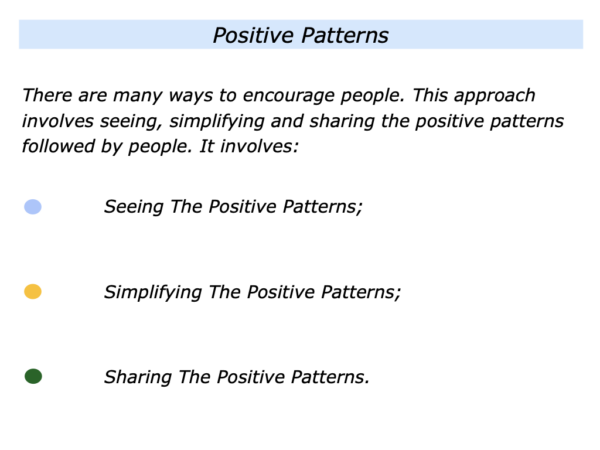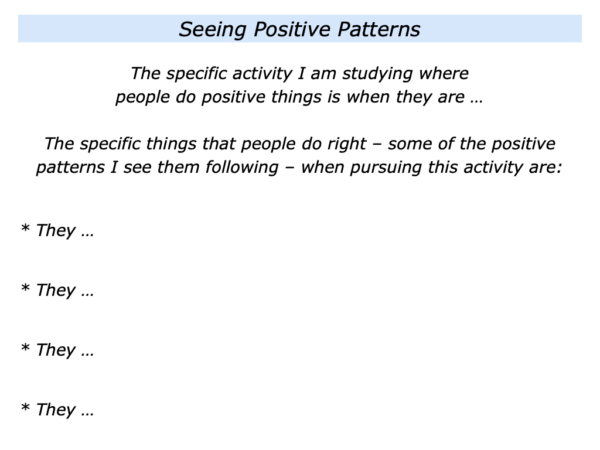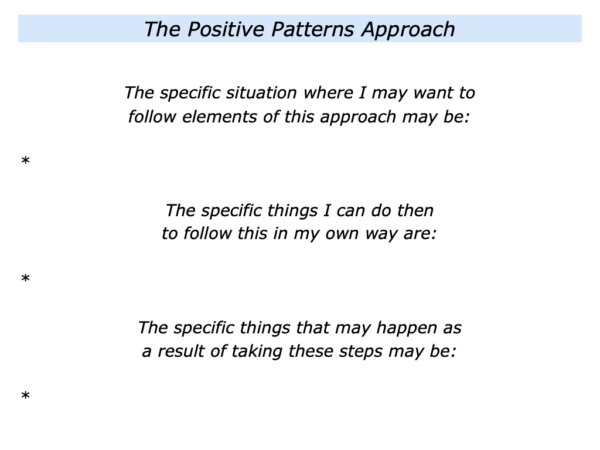
This approach starts by studying people who are doing positive things in their lives or work. It then involves seeing, simplifying and sharing the positive patterns that people follow.
Many educators take this approach. They also pass practical tools that people can use to follow these patterns in their own ways. This involves focusing on the following steps.
Seeing The
Positive Patterns
Great educators start by studying people who do positive things in their lives or work. They may aim:
To study people who encourage others, overcome challenges or work to achieve specific goals;
To study people, teams or organisations that build on their strengths, do superb work and achieve success;
To study people, groups or organisations who do positive work that cares for people or cares for the planet.
Great educators sometimes watch these people in action or see an example of their work. They then explore the following questions.
What are the positive things that people are doing? What are some of the things that happen as a result? What are the benefits?
What are people doing right when they do these activities? What are the principles they are following? How do they translate these into action?
Looking at what people do right, can I see any recurring patterns? Are there any patterns that people pursue to get positive results?
Such educators may then summarise what they see by doing the following exercise.

Imagine that a person has gathered information about what people do right. They may have also begun to summarise these into describing some of the patterns. This can lead to the next stage.
Simplifying The
Positive Patterns
Great educators then aim to simplify the positive patterns. Looking at the information they have gathered, some may do this by taking the following steps.
They clarify the positive patterns they have discovered;
They aim to summarise and simplify these patterns – but in a profound way;
They translate these patterns into a model or other media that they can share with people.
Different people do this in different ways. Some do it by again exploring the following questions.
What do people do right when doing the specific activity? What are the positive patterns they follow? What are the benefits of them following these patterns?
How can I summarise and simplify these patterns in a profound way? How can I translate these into an illustration, model or other media? How can I create something that is possible to pass on to people?
Great educators may then create a model that summaries the patterns. They then take the following steps.
They keep testing the model to make sure it works in reality;
They keep clarifying how to bring the model to life with real examples;
They keep polishing the model until they feel it is both simple and profound.
Imagine that a person has been able to simplify the patterns in a way that can be helpful to people. This may lead to them taking the next step.
Sharing The
Positive Patterns
Great educators often follow the philosophy that the learner learns what the learner wants to learn. When appropriate, they take this approach when sharing the positive patterns with people.
Such educators prepare properly before meeting a person, teaching a class or running a workshop. This involves exploring the following themes.
Who is the person or group of people I am going to meet? What is happening in their world? What may be the challenges they face or the specific goals they want to achieve?
What may be the topics they want to explore in the session? How can I make clear contracts with them about the goals to achieve in the session? How can I then do my best to run a successful session?
How can I create a positive environment? How can I focus on the first goal they want to explore? How can I clarify the real results they want to achieve? How can I clarify their picture of success?
How can I, when appropriate, pass on knowledge they can use to achieve their aims? How can I share some of the positive patterns they may wish to follow? How can I do this in a way they can use in their lives or work?
If appropriate, how can I clarify the route they want to follow to achieve their aims? How can I pass on practical tools they can use in their own way? How can I encourage, educate and enable them to achieve success?
There are many ways to encourage people. One approach is to share the positive patterns that some people follow in their lives or work. It is also to offer practical tools that people can use to follow these in their own way.
Let’s return to your own life and work. Looking ahead, can you think of a situation where you may want to follow elements of the positive patterns approach? How can you do this in your own way?
If you wish, try tackling the exercise on this theme. This invites you to complete the following sentences.



Leave a Reply